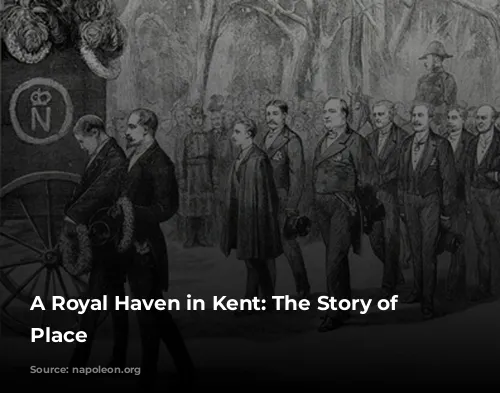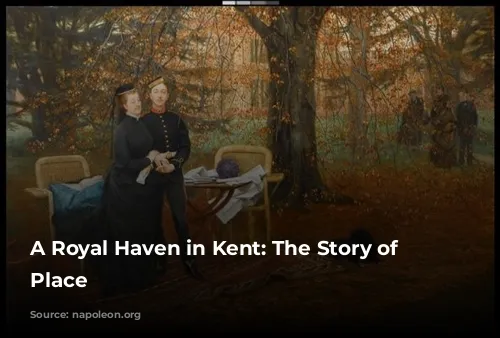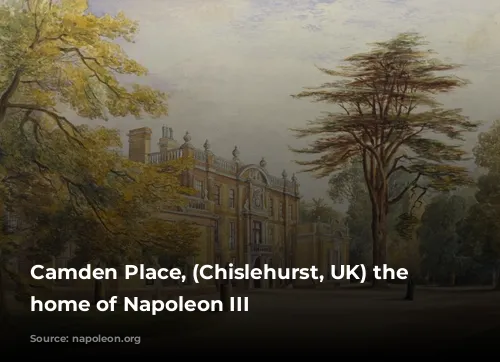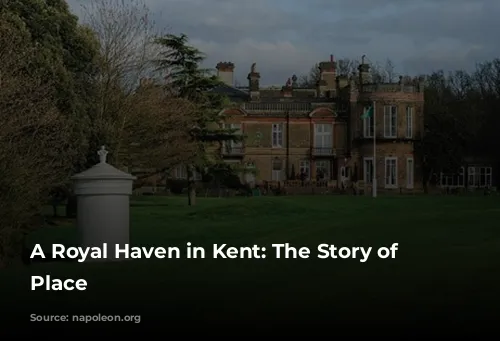Camden Place, nestled in the tranquil countryside of Kent, holds a captivating history intertwined with the fate of a fallen emperor and his family. This once-grand Georgian manor became a haven for the French Imperial family in exile, a place where they sought refuge and plotted their return to power.
A House for an Emperor
Political upheaval in France forced the French Imperial family to seek sanctuary across the English Channel. England, known for its tolerance and political freedoms, welcomed refugees with open arms. The Imperial family, particularly close to Queen Victoria, found a safe haven in the proximity of France, choosing Kent as their new home.
Camden Place quickly transformed into the center of the French court in exile. The French flag proudly fluttered in the wind, and illustrious visitors, including royalty like Queen Victoria and Czar Alexander II, graced its halls. Political discussions filled the rooms as plans to reclaim the throne were meticulously debated. Even the Republicans, eager to monitor the family’s activities, stationed spies in a nearby windmill, only to find themselves under the watchful eyes of Napoleon’s own spies.

The Mystery of Camden Place’s Acquisition
The intriguing acquisition of Camden Place by Nathaniel Strode in 1860 remains a subject of much speculation. Strode, a banker with a keen eye for detail, transformed the house from a typical English manor into a luxurious French chateau. He incorporated elaborate panelling from the Château de Bercy, adorned the walls with French and Flemish art, and furnished the house to reflect the refined tastes of the French aristocracy.
But why did Strode choose this house, and how did it come to be the refuge of the French Emperor?

A Web of Relationships
The answer lies in a complex network of relationships and a touch of mystery. Strode had known Louis-Napoleon, the exiled emperor, during his time in London in the 1830s and 1840s. Their connection was further strengthened by Harriette Howard, a long-time mistress and friend of Napoleon’s, who had financially supported his political campaigns. Historians suggest that Emily Rowles, a childhood friend of Napoleon’s, may have played a role in his eventual arrival at Camden Place.
Strode claimed to have had a premonition that Camden Place would become a necessary haven for the emperor. While this appears rather prophetic, financial records reveal that Strode received substantial sums of money from the French Civil List, adding fuel to the fire of speculation.

A Refuge for the Empress
In 1870, Empress Eugénie, fleeing the turmoil of the Franco-Prussian War, found herself seeking shelter. Strode, with remarkable timing, offered Camden Place as a safe haven. The Empress, unaware of Strode’s personal connection to her husband and his role in Harriette Howard’s affairs, accepted his generous offer.

The Emperor’s Final Days
At Camden Place, Napoleon III, embracing the quiet life of a country gentleman, walked to church, watched cricket matches, and traveled by train to London. He became a beloved figure in the community, often distributing pennies to the local children.
Despite his newfound peace, Napoleon’s health continued to deteriorate. The bladder stones that plagued him during his final days as emperor returned with a vengeance, leading to his tragic death in 1873. His passing sent shockwaves through the small village of Chislehurst, as mourners flocked from across the country and beyond to pay their respects.
A Legacy of Remembrance
Camden Place continued to play a significant role in the Imperial family’s story. The Prince Imperial, son of Napoleon III, celebrated his coming-of-age at the house, and years later, Chislehurst became the final resting place for both the emperor and his son.
The town of Chislehurst forever holds a special place in French history, forever remembering its former Imperial residents. Street names like Royal Parade, Empress Drive, and Prince Imperial Way serve as constant reminders of the time when a French emperor and his family sought refuge in this quiet English village.

A Place to Reflect on History
Today, Camden Place, now the clubhouse for the Chislehurst Golf Club, remains a testament to the past. Its interiors, largely unchanged, offer visitors a glimpse into the lives of the Imperial family. Golfers, enjoying the grounds where the Imperial family once walked, can’t help but be reminded of the rich history that unfolded within these walls. Camden Place stands as a poignant reminder of the power of history, the resilience of the human spirit, and the enduring legacy of a family forced to seek sanctuary in a foreign land.







